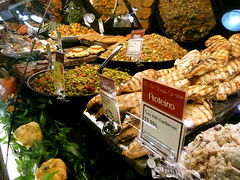How healthy do you look and feel? What you eat could make a difference. While food makes us healthy, if we’re not careful, it can make us unhealthy too. If you eat the right foods you could escape many of the toils of aging–and hang on to your health and good looks longer.
What constitutes the right food or good nutrition would appear to be a controversial issue, judging from the range of opinions expressed in the media, in the market and by the neighbor down the street or Mother’s Aunt Susie.
But nutrition needn’t be all that controversial–nor dietary advice all that conflicting. The noise reflects a changing of the guard necessitated by increased knowledge about how foods interact with the body. Much of the controversy and conflict in opinion is exaggerated to score rhetorical points.
In the past fifty years, a great deal of research has identified close links between diet and disease. The focus is on some of our favorite foods and on such widespread disease as cancer, heart disease, diabetes and stroke—not to forget obesity.
From that research has grown a consensus among the vast majority of specialists in various health areas. With only minor differences, most groups offer these general nutritional guidelines–appropriate for review during March, National Nutrition Month.
- Consume a variety of foods in a form that best retains the nutrient content. Most of us first learned about good nutrition in terms of basic food groups. Whether the number of groups was seven, four or five, we learned that a variety of food was needed for good nutrition. That message hasn’t changed.
- Limit the intake of any single nutrient to that amount which is needed, therefore avoiding an imbalance of other nutrients. It’s a balancing act of sorts–getting enough of the foods that are important to good nutrition but not too much of things that cause problems. In short, your diet should contain less fat, sugar, salt, caffeine and alcohol, and more foods rich in dietary fiber.
Unfortunately, some of the foods we should be eating less of, such as soda pop, bacon, hot dogs, beer, cream, salted processed foods, etc., are produced by industries that are doing everything in their power to block dietary changes that would reduce company profits. That’s what much of the noise and controversy are all about.
- Control weight by balancing the amount of energy consumed with the amount of energy burned through activity and exercise. People may buy and eat more “good” foods today but then reward their virtue with high calorie, artery-clogging treats. The sale of rich desserts and snacks is booming. People may exercise more regularly than ever before, but they also skip meals–a not so healthy practice that throws the metabolic rate out of whack.
- Beware of fad diets in any form, especially those that are sold in the name of science. They suffer from the “popcorn effect,” wherein a kernel of truth is so puffed up with hot air that it can mislead and possibly harm. If some of a nutrient is good, more is not always better. Too much of one food could limit the intake of others. Too much of one nutrient could block the body’s ability to absorb another. A balanced variety of foods is still the message that needs to be learned.
Although these guidelines are relatively simple it’s the method of delivery–the meal–that actually “sells” the message. While we may want our meals to be healthful, we also want them to taste good, and we want them ready fast!
Given today’s complex lifestyle, with less time spent on shopping and cooking, it’s worth the time it takes to plan a score or more of meals we can rely on to provide proper nutrition, meals that will be fast to fix, meals that will be good to eat. The meal is the key to getting the nutrition message across.

